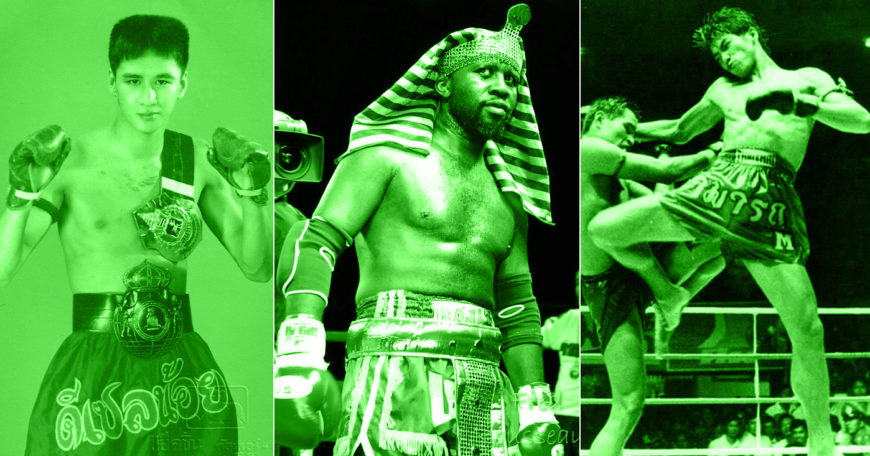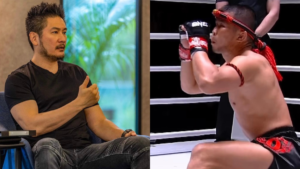The ‘Golden Era’ of Muay Thai existed from the 1980’s to the mid 90’s and is considered the pinnacle of the sport. This fifteen year period exhibited Thailand’s best and most revered fighters. It is said that the quality of fights and athletes has never again been able to reach the same heights.
We still have our modern legends like Saenchai, or Buakaw but most opinions are in agreement that they do not match the caliber of Golden Era fighters. The training was reportedly harder back then, the talent pool was much larger and the match ups were extremely well paired to deliver the most explosive and exciting fights.
Today, fighters and coaches look to and study the era like an encyclopedia of technique and tactic. One thing is for sure, it is an incredible resource not to be missed. Here we take a look at the biggest names of the Golden Era and what made them so legendary.
1- Samart Payakaroon:
Born in 1962, Samart Payakaroon is widely considered the best Muay Thai fighter of all time. He began his training at just 7 years old in East Thailand before moving to Pattaya in 1975 to study under Master Yodtong Senanan, at his famed Sityodtong Camp. Kru Yod, as he is more affectionately known, is himself considered to be one of the greatest Muay Thai teachers to have ever lived, having created the most champions in Thai history.
Samart went on to win 4 Lumpinee titles (winning his first at 17) in four different weight classes.
Also hailed as the ‘Muhammad Ali of Thai Boxing’, he later proved his prowess in Western Boxing, earning the WBC green belt title in 1986. He had to switch his stance to Southpaw in order to quell his instinct to use elbows, kicks and knees.
Samart had a sixth sense for timing knockouts and was extremely accurate in anticipating opponents’ offense. His nonchalant style of fighting would lure his opponent in, where he would quickly exploit their weakness or mistakes. His slick movements made opponents look like amateurs, and many of them were also some of Thailand’s best fighters. His style of fighting is considered the hardest to master. Muay Femeu fighters are technically gifted and seemingly strike without being seen.
Having amassed 150 fights with 129 wins, it’s hard to choose the best one but below he faces Japanese fighter Nizuma Shirato with his signature ease and accuracy.
2- Dieselnoi Chor Thanasukarn:
Dieselnoi is another undisputable great of Thai boxing. His unusual height of 6’2” and signature method of attack earned him the name ‘sky piercing knee’. Out of 116 fights, he only lost 5 and drew 1. Over half of his wins were by knockout.
He was so good, many refused to fight him. As a result, he had to endure the occasional gap in challengers. And this was before he fought and defeated Samart with his trademark knees. He spent over a year and a half without any opponents after he had beaten Thailand’s greatest fighter.
He is the best Muay Khao (knee fighter) there ever was. He retired at age 25 as an undefeated Lumpinee champion.
Check out his epic win against Samart:
3- Jongsanan Fairtex:
Also known as ‘The Wooden Man’, Jongsanan was born in Northern Thailand into extreme poverty. He knew by 7 years old that he wanted to be a fighter. He eventually found himself at Fairtex gym where he started work as a janitor and spit boy. He was overlooked as a poor farm boy and, as a result, was refused training. A fight pullout at his weight would eventually provide him the opportunity he so desperately needed. Despite his lack of proper training, Jongsanan won the fight, and the trainers finally took notice of him and allowed him to begin official schooling at the camp.
He experienced a meteoric rise to fame – collecting two Lumpinee titles along the way – which earned him a lot of money and attention. Unfortunately, he was notorious for spending it as quickly as he received it. This irresponsibility led to a major career loss and his popularity among the Thais began to wane.
Not long after, he moved to America to Fairtex San Francisco where he met his next coach, Ganyao Fairtex. Under his tuition he once again flourished, he went undefeated from 1998 to 2005.
He was known for his knockout power and his dominance in the clinch, having excellent abilities to sweep and throw his opponent off balance. His rivalry with Sakmongkol was notorious, having faced each other on numerous occasions which resulted in one of the most celebrated elbow fights of all time.
4- Sakmongkol Sithchuchok
‘The King of Muay Thai’ is Lumpinee Stadium royalty, having fought there exclusively between 1989 and 1995. Having had his first fight there at just 12 years old, he went on to become a 3 x Lumpinee Champion as well as a 5 x WMC World Champion. He only lost two fights during that entire time, but managed to beat both those opponents at a subsequent rematch.
Sakmongkol totalled 232 fights and only 19 losses. As was common during the time, there were multiple rematches. He fought Orono Por Muang Ubon four times while his most famous rival, Jongsanan was met a total of 7 times. Their 5th fight went down in history as one of the greatest elbow fights to have ever occurred.
As a Southpaw, his devastating left kick has broken more than a couple of arms. His fight against Perry Ubeda resulted in just this. He is one of the hardest kickers Muay Thai has ever seen. Watch the fight here.
5- Orono Por Muang Ubon
This 3 x Lumpinee champion is lesser known than some of his counterparts but, nevertheless, he has beaten some of the best in the sport, including Ramon Dekkers and John Wayne Parr.
Needless to say, The ‘King of the Face Teep’ had an extremely aggressive fight style that was entertaining from start to finish. His fight style was ‘Muay Bouk’, a forward and aggressive style that is relentless and relies on constant pressure to overpower the other fighter.
Despite his prowess, he was no match for Sakmongkol who beat him a total of four times in just one year. However, he is still ranked by many as one of the top ten fighters of that era.
Both pressure fighters, sparks fly as Orono takes on Dekkers here.
6- Sagat Petchyindee:
Sagat had over 300 fights in his career, successfully dominating competition across 3 different sports. He is a 3x Lumpinee champion, and Rajadamnern champion as well as a Muay Thai, Kickboxing and Boxing world champion.
Born the 7th of 10 children, Sagat was introduced to Muay Thai by one of his brothers at age 11.
No surprises here though, he comes from a long line of Muay Thai fighters and champions. He was a local star until he was scouted at 16 and invited to train in Bangkok. There he won Rajadamnern’s first full tournament before achieving another 7 Muay Thai titles. He became a knockout king, effectively using the uppercut to beat his opponents.
Some may recognise the name as Streetfighter muscled, one-eyed, Thaiboxer. Although never officially acknowledged, Sagat is widely believed to be the inspiration for this character. He retired at 28 years old, before travelling the world to share his teachings.
Never short of heart, Sagat beats the talented Ronnie Green here.
7- Ramon Dekkers:
Dekkers is, without contest, a Muay Thai legend, and one of the few foreigners that could hold his own with the greats of the Golden Era. He is a Dutch kickboxer and 8 x Muay Thai champion.
He tried Judo and Western Boxing briefly before finding and falling in love with Muay thai aged 12. He studied under the highly respected and previous Netherlands number 1, Cor Hemmers (who later became his step-father).
His first fight, aged 16, resulted in a knockout defeat for his opponent. 2 years later he would receive his first title, one of many over the course of his career. He gained popularity among the Muay Thai community as his fast paced and aggressive style wowed the audience and was highly effective against his competition.
“The Diamond” is considered the greatest Muay Farang (foreign fighter) of all time, with many of Thailand’s best in agreement. Although he lost many of his fights in Thailand, he later blamed the scoring systems that differed in Thailand compared to europe. Nevertheless, he is very much respected due to his tenacity and ferociousness in the ring and his ability to go the distance with other legends of the Golden Era.
He tragically passed away from heart failure in 2013.
Another popular Golden Era rivalry, Ramon first fought Coban in ‘91, resulting in him getting knocked out. However they fought again later that year with Dekkers taking the win. They would go on to fight two more times, each seeing victory one more time. Here’s Dekkers’ first win against Coban.
8- Coban Lookchaomaesaitong:
The son of poor farmers, Coban saw fighting as an opportunity to leave poverty behind. Declaring he would become the best fighter in Thailand, he took up his training at the age of 11.
He taught himself by mimicking local fighters with his makeshift gym equipment.
His talent and ingenuity did not go amiss. A local doctor decided to sponsor his training to reward his determination. He fought 35 fights by age 15 and became a Lumpinee champion at age 19.
His career saw almost 300 fights over 23 years. He fought Ramon Dekkers a total of four times, winning two and losing two. These fights are lauded as some of the best fight viewing ever available. Here is their third fight and Coban’s final win against Dekkers.
9- Dany Bill
Dany Bill is also one of Muay Thai’s biggest names and one of the few truly respected farang fighters, along with Ramon Dekkers. Cameroon born, but French raised, Dany Bill knew as soon as he saw Muay Thai on tv that he would have to take up the sport. He immediately joined Nemrod Gym in his home city of Stains.
He went on to have his first fight at 14, achieving his first national title a year later. He became the first European fighter to win a World title in Thailand and successfully contested his status over the next 7 years. Following on from Thai boxing, he competed in European kickboxing in the 2000’s before his final fight in 2011.
Like others on this list, he too lost to Coban and Sakmangkol, however he does hold an impressive win over Dekkers and two over Orono Por Muang Ubon. Watch their fist fight here for perfectly timed sweeps and jabs.
10- Boonlai Sor Thanikul:
Another forgotten legend, Boonlai was trained by his father before moving to Bangkok aged 13. Him and his twin brother, Boonlung, were the most famous twins in Muay Thai, before Boonlung died in a car accident after their move to Bangkok.
Considered a ‘technical magician’ of the sport, he clocked in over 400 fights in 4 different weight classes over the span of his career. He became a Lumpinee champion in 1992, and again in 1994 beating another revered fighter of the time, Wangchannoi. He also beat Jongsanan.
He now runs Sor Korpilap, opened in 2010, in the same district as the gym that made him famous, Sor Thanikul.
Watch his fight for the Lumpinee title against Oley Kiatoneway here. Their evasion and gravity defying athleticism is truly something to behold.
Wrapping Up:
Muay Thai has changed substantially in recent decades. From the scoring, to the influence of gambling and a receding number of fighters, it has adversely affected fights in Thailand compared to The Golden Era.
The most significant difference, however, is the talent pool. As you can see here, the best fought the best many times over. Competition was at its highest and propelled any fighter during that time to new heights.
Today, watching the rise and prominence of One Championship (owned by Chatri Sidyodtong, a Thai fighter under Kru Yod himself), they seem to pave the way for a new era of martial arts viewership and competition. But, we can only fully appreciate things on reflection and in comparison.
Who knows if this renewed interest in martial arts will guide us to another Golden era. Whatever the case may be, it’s safe to say that these Golden Era legends deserve the acclaim and admiration that has been bestowed upon them.









